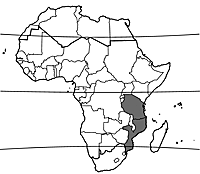Introduction |
Bonamia mossambicensis (Klotzsch) Hallier f.
- Protologue: Bot. Jahrb. Syst. 18: 91 (1894).
- Family: Convolvulaceae
- Chromosome number: n = 15
Origin and geographic distribution
Bonamia mossambicensis occurs in Tanzania and Mozambique.
Uses
In Tanzania a root decoction of Bonamia mossambicensis is drunk to treat palpitations, mental illnesses and intestinal worms. A leaf and root decoction is drunk to treat abdominal pain, and a plant decoction with sugar is drunk to treat schistosomiasis. Leaf or root powder is applied to wounds to improve healing.
Production and international trade
Bonamia mossambicensis is only traded on a local scale.
Properties
In a preliminary analysis, triterpenoids were isolated from the leaves. Different extracts from the leaves and roots showed a high level of in vitro antifungal activity against Trichophyton mentagrophytes and Candida albicans, but had no activity against Staphylococcus aureus.
Description
Shrubby climber up to 5 m long. Stems woody, velvety with patent and tangled hairs, white or grey, but golden brown when dry. Leaves alternate, simple and entire; petiole up to 1 cm long; blade elliptical-lanceolate to oblong-ovate, 2.5–11.5 cm × 1–4.3 cm, apex acute and mucronate or apiculate, base rounded or slightly cordate, velvety pubescent above, densely coated with brown hairs beneath, rather leathery. Inflorescence an axillary or terminal head-like cyme, many-flowered, densely hirsute; peduncle up to 4 cm long; bracts 1–1.5 cm long. Flowers bisexual, regular, 5-merous; pedicel short; sepals unequal, elliptical-oblong, up to 9 mm long, acute, glabrous except the apex of the outer ones; corolla funnel-shaped, up to 3 cm long, not distinctly lobed, bright blue, pilose outside; ovary superior, hairy at the apex, 2-celled, style unequally bifid above the middle, stigmas ovoid. Fruit a globose-oblong capsule, pilose, 4-valved, 2–4-seeded. Seeds oblong, brownish, edged with narrow hyaline golden wings.
Other botanical information
Bonamia is a pantropical genus with c. 45 species, of which c. 15 occur in tropical Africa and the Indian Ocean islands.
Bonamia thunbergiana
Bonamia thunbergiana (Roem. & Schult.) F.N.Williams from West Africa has magico-medicinal uses. In Côte d’Ivoire pounded and moistened leaves are put in the nostrils of dogs to improve their scent. In Madagascar a leafy twig infusion of an unidentified Bonamia species is taken to treat conjunctivitis.
Bonamia spectabilis
An infusion of the roots of Bonamia spectabilis (Choisy) Hallier f. from Madagascar and East Africa, is taken in Madagascar as a purgative, and to treat stomach-ache and back-ache. A leafy twig infusion is externally applied to conjunctivitis. Significant antiplasmodial activity against both the chloroquine-sensitive and chloroquine-resistant clones of Plasmodium falciparum has been reported for several of the sesquilignans bonaspectins E–H and the neolignan virolongin A isolated from the aerial parts. From the roots the tropane alkaloids bonabilines A and B were isolated; bonabiline A showed to be a significant antagonist to muscarinic M3 receptors in isolated guinea-pig ileum. Bonamia spectabilis has beautiful blue flowers and would be well-suited as an ornamental.
Ecology
Bonamia mossambicensis occurs in savanna thickets, open woodland, coastal scrub, forest margins and along roadsides, from sea-level up to 800 m altitude.
Propagation and planting
Bonamia mossambicensis is propagated by seeds.
Genetic resources
Bonamia mossambicensis is not very widespread, but is relatively common. There are no signs of genetic erosion.
Prospects
Bonamia mossambicensis has some interesting medicinal uses, indicating antibacterial and antifungal activity. These uses have been partially confirmed but more research is needed to evaluate its possibilities to develop safe medicines.
Major references
- Deroin, T., 2001. Convolvulaceae. Flore de Madagascar et des Comores, familles 133 bis et 171. Muséum National d’Histoire Naturelle, Paris, France. pp. 11–287.
- Neuwinger, H.D., 2000. African traditional medicine: a dictionary of plant use and applications. Medpharm Scientific, Stuttgart, Germany. 589 pp.
- Verdcourt, B., 1963. Convolvulaceae. In: Hubbard, C.E. & Milne-Redhead, E. (Editors). Flora of Tropical East Africa. Crown Agents for Oversea Governments and Administrations, London, United Kingdom. 161 pp.
Other references
- Boiteau, P., Boiteau, M. & Allorge-Boiteau, L., 1999. Dictionnaire des noms malgaches de végétaux. 4 Volumes + Index des noms scientifiques avec leurs équivalents malgaches. Editions Alzieu, Grenoble, France.
- Gonçalves, M.L., 1987. Convolvulaceae. In: Launert, E. (Editor). Flora Zambesiaca. Volume 8, part 1. Flora Zambesiaca Managing Committee, London, United Kingdom. pp. 9–129.
- Khan, M.R., 2001. Antibacterial activity of some Tanzanian medicinal plants. Pharmaceutical Biology 39(3): 206–212.
- Kraft, C., Jenett-Siems, K., Köhler, I., Tofern-Reblin, B., Siems, K., Bienzle, U. & Eich, E., 2002. Antiplasmodial activity of sesquilignans and sesquineolignans from Bonamia spectabilis. Phytochemistry 60: 167–173.
- Myint, T. & Ward, D.B., 1968. A taxonomic revision of the genus Bonamia (Convolvulaceae). Phytologia 17(3): 121–239.
- Ott, S.C., Jenett-Siems, K., Pertz, H.H., Siems, K., Witte, L. & Eich, E., 2006. Bonabiline A, a monoterpenoid 3a-acloxytropane from the roots of Bonamia spectabilis showing M3 receptor antagonist activity. Planta Medica 72: 1403–1406.
- Sawhney, A.N., Khan, M.R., Ndaalio, G., Nkunya, M.H.H. & Wevers, H., 1978. Studies of the rationale of African traditional medicine III. Preliminary screening of medicinal plants for antifungal activity. Pakistan Journal of Scientific & Industrial Research 21(5–6): 193–196.
- Tofern, B., Jenett-Siems, K., Siems, K., Jakupovic, J. & Eich, E., 2000. Bonaspectins and neobonaspectins, first sesquilignans and sesquineolignans from a convolvulaceous species. Phytochemistry 53: 119–128.
Afriref references
Sources of illustration
Author(s)
- G.H. Schmelzer PROTA Network Office Europe, Wageningen University, P.O. Box 341, 6700 AH Wageningen, Netherlands
Correct citation of this article
Schmelzer, G.H., 2013. Bonamia mossambicensis (Klotzsch) Hallier f. In: Schmelzer, G.H. & Gurib-Fakim, A. (Editors). PROTA (Plant Resources of Tropical Africa / Ressources végétales de l’Afrique tropicale), Wageningen, Netherlands. Accessed 1 June 2025.
- See this page on the Prota4U database.

